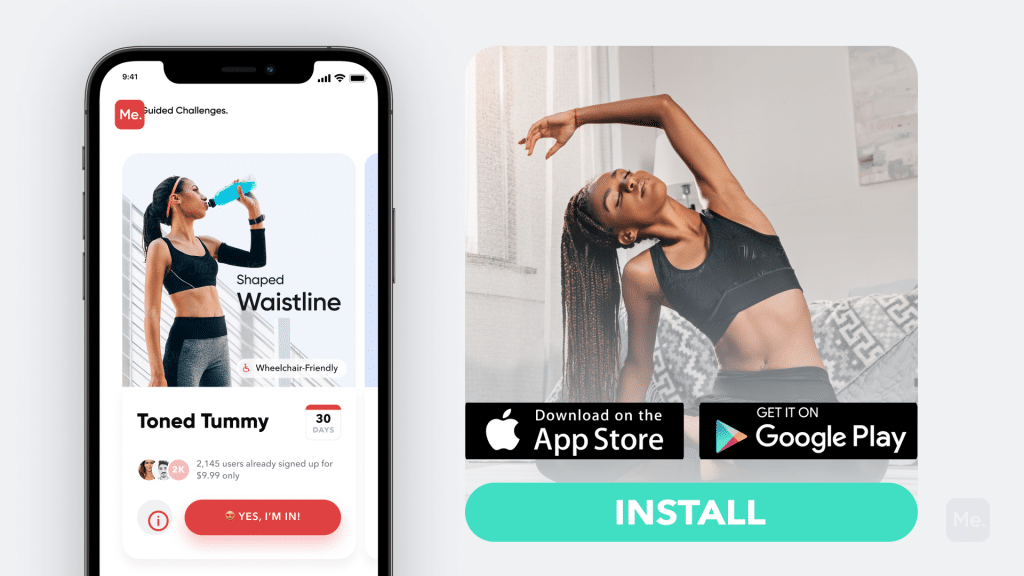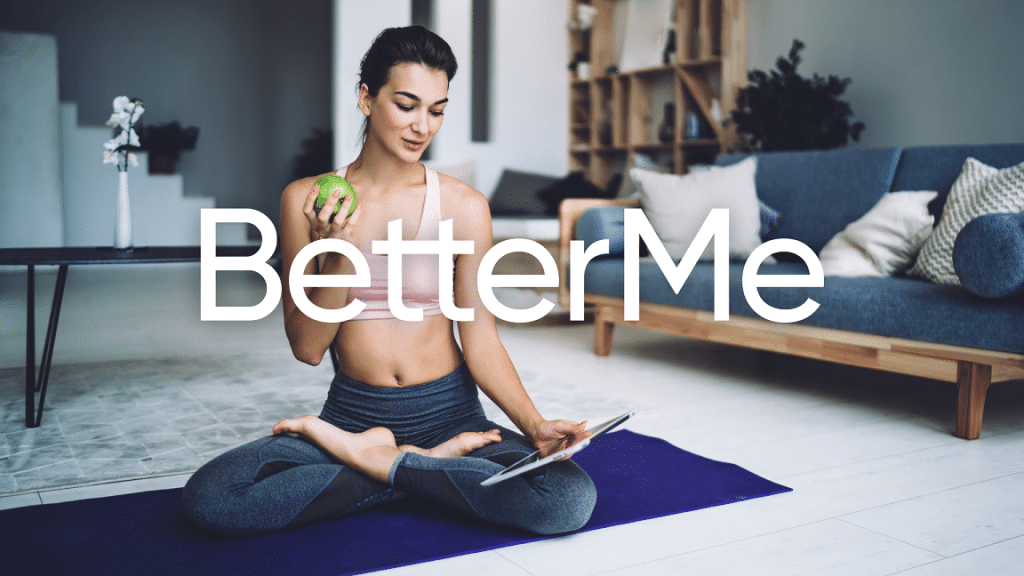Sitting in front of a computer all day, every day can be really hard on your body. It causes muscle imbalances and tightness, especially in the back and neck muscles. You can help to relieve these issues by stretching regularly throughout the day. Stretching also helps reduce the chance of repetitive motion injuries like carpal tunnel syndrome which is common among office workers who type constantly throughout the day. In this article, we will show you how to do some quick exercises for office workers that increase flexibility and help prevent injury.
Get your personalized
meal plan!
Shoulder Shrugs
Sitting hunched over your keyboard can cause your shoulders to round forward. This posture can lead to postural headaches, tight neck muscles and shoulder tension (6).
Doing the shoulder shrugs exercise will help strengthen your upper back and neck muscles, improve your posture and relieve muscle tension in these areas.
To do this exercise:
- Sit up straight with your feet flat on the floor and shoulder-width apart.
- Keep your arms straight by your sides, with palms facing down.
- Relax your shoulders then shrug them up as high as you can, hold for a second or two, then release back to the starting position.
- Repeat 15 times.
Exercises For Office Workers: Chest Stretch
A great way to relieve tension in your neck and upper back is to stretch your chest muscles.
To do this exercise:
- Sit up straight with your feet flat on the floor and shoulder-width apart.
- Stretch your arms behind you and, if you can, lace your fingers together. Stretch your arms until you feel a stretch in your chest
- Take a deep breath and hold for 10 seconds then exhale.
- Bring your arms up and back as far as you can.
- Feel the stretch across your chest and hold for 15 seconds.
- Repeat 5 times.
Neck Rolls
Doing neck rolls regularly is a great way to reduce tension in your neck muscles and improve your posture. It also helps to relax tight jaw muscles caused by stress or sinus irritation, and prevents the chest muscles from getting too tight.
To do this exercise:
- Sit up straight with your feet flat on the floor and shoulder-width apart.
- Keep your head still and slowly roll it to one side, as though you were looking over your shoulder until you feel a stretch along the side of your neck (not too far though,)
- Take a deep breath and hold for 5 seconds then exhale. Repeat this 10 times.
- Slowly roll your head to the other side and repeat for 10 more repetitions.
- Make sure you are not rolling your head so far as to cause pain in your neck. Only go as far as feels comfortable for you.
Read More: 10 Family Exercise Ideas That Are Fun And Effective
Exercises For Office Workers: Head Tilt
Another great exercise for good posture is the head tilt. This stretches your neck muscles and helps to relieve tension that can build up when you sit in one position all day typing.
To do this exercise:
- Sit up straight with your feet flat on the floor and shoulder-width apart.
- Keep your head still and slowly tilt it towards one shoulder until you feel a stretch, then hold for 5 seconds before returning to a neutral position.
- Repeat this 10 times then switch shoulders.
Arm Circles
Typing away at your desk all day can also cause muscle imbalances in the arms.
Doing arm circles is a great way to help improve these imbalances.
To do this exercise:
- Sit up straight with your feet flat on the floor and shoulder-width apart.
- Extend your arms out to the sides at shoulder height.
- Move your arms in a circle, first moving them up to the ceiling then bringing them down until they are at shoulder height on the other side.
- Repeat this 10 times in both clockwise and anti-clockwise directions.
Exercises For Office Workers: Hand Clenches & Releases
The muscles in your hands can become tense from typing all day which not only causes discomfort but it can also lead to arthritis in the joints.
Doing hand clenches and releases is a great way to stretch out these muscles.
To do this exercise:
- Sit up straight with your feet flat on the floor and shoulder-width apart.
- Keep your arms straight by your sides, with palms facing down.
- Focus on keeping your shoulders relaxed.
- Clench your hand into a fist, making sure to keep your thumb outside the fingers. Hold for 5 seconds then release slowly. Repeat this 10 times.
- Tighten your hand into a fist again, but this time with the thumb inside the palm of your hand. Hold for 5 seconds then slowly release.
- Repeat this 10 times.
Seated Leg Extensions
One way to reduce the tension in your hips and lower back is by doing seated leg extensions. This exercise also helps strengthen and stabilize your core, which can help improve your posture while sitting at a desk all day.
To do this exercise:
- Sit up straight with your feet flat on the floor and shoulder-width apart.
- Keep your shoulders relaxed and place your hands on the edge of your desk in front of you for support.
- Lift one leg up, keeping it as straight as possible, until it is level with the hip or above. You can either keep this leg bent or you can extend it a few times to build strength, then switch to the other leg.
- Hold for 5 seconds and lower your leg slowly before repeating with the other one. Repeat this 10 times (5 on each side)
Exercises For Office Workers: Spinal Twist
The spine twist is a great exercise for stretching the lower back and abdominal muscles. It also helps to get rid of any excess tension in your back muscles.
To do this exercise:
- Sit up straight with your feet flat on the floor and shoulder-width apart.
- Keep your head still and slowly twist your upper body to one side until you feel a stretch in your opposite hip or lower back, hold for 5 seconds then return to neutral position.
- Repeat this, while contacting your abs for an added lower back stretch, 10 times before twisting the other way.
BetterMe app is a foolproof way to go from zero to a weight loss hero in a safe and sustainable way! What are you waiting for? Start transforming your body now!
Hip Flexor Stretch
Your lower body suffers when you’ve been sitting in one position for a long time because your hip flexors are shortened. The result is tightened muscles and poor posture.
This stretch can help to reduce the tension and pain that build up in your hips and lower back.
To do this stretch:
- Stand up straight with your feet hip-width apart.
- Take your right leg back a few feet , bending your knee until you feel a stretch in the front of your right hip or upper thigh, hold for 5 seconds then return to standing position.
- Repeat this 10 times.
- Switch legs and do the same number of repetitions for your left leg.
- If you are feeling particularly ambitious try bending both knees at the same time, while squeezing your glutes to deepen the stretch
- Hold for 10-30 seconds.
Perfecting Your Sitting Posture In The Office
Along with exercises, you must always sit with correct posture as that is the only way to stay healthy (5). The good news is that practicing these simple tips will help you to naturally maintain a proper sitting position:
- Keep your feet flat on the floor and shoulder-width apart.
- Your hips should always be above your knee, so when you sit in your chair, make sure that your hips are higher than your knees.
- Your elbows should be bent at a 90-degree angle while typing.
- Keep the top of your monitor level with your eyes to prevent neck strain and use an external keyboard if possible.
- Sit back in your seat so that your whole back is supported.
- The natural curve of your lower back should fit perfectly against the curve of your seat.
- Your seat’s backrest should be slightly reclined (10-15 degrees).
- Always relax your shoulders. When working at a computer, your shoulders should be relaxed down and back.
- Keep your head level while looking straight ahead.
Read More: Motivation To Exercise When Tired: Where Do You Find It?
Effects Of Poor Sitting Posture
As an office worker, you should know the importance of the correct sitting posture. Some of the effects of sitting poorly and spending too much time at your desk include:
Carpal Tunnel Syndrome (CTS)
According to the Centers for Disease Control (CDC), CTS is one of the most common work-related musculoskeletal disorders (8) CTS is caused by compression of the median nerve at the wrist (4).
Slouching and having your wrists below elbow level while typing can contribute to CTS, so it is important that you sit up straight, keep your elbows bent at 90° degrees and keep your keyboard on the same level as your elbows.
Lower Back Pain
Lower back pain that is a result of long hours of being seated in an office chair, slouching over your keyboard or even just sleeping in bad posture can be extremely painful and frustrating (2).
In order to prevent this from happening to you, make sure that you sit straight, lean against your chair’s back support and stretch out your lower back muscles every hour.
Neck And Shoulders Pain
The muscles in your neck and upper back can get incredibly tight, especially if you spend long hours sitting in an office chair and staring at a computer monitor. It is important that you look away from your screen for a second to relax these muscles and allow them to stretch out.
Furthermore, make sure that you sit up straight, keep your shoulders relaxed and don’t shrug.
Intense sweat sessions, working weight loss tips, lip-smacking recipes come in one package with the BetterMe app. And all of it is at your fingertips, start transforming your life now!
Arthritis
The term arthritis is used to describe more than 100 rheumatic diseases and conditions that affect joints, the tissues which surround the joint and other connective tissue (1). Joint s that are affected by arthritis, become swollen and stiff and the joint’s range of motion goes down.
Many times those suffering from arthritis mistake it for a simple neck or back pain, so they don’t go to their doctor. If you notice swelling, stiffness, and pain in your joints, visit your doctor as soon as possible as this could be a sign of arthritis.
Certain occupations are more prone to developing arthritis of the knee and hip (7). These include office workers in the service industry who have prolonged periods of working in either a seated or standing position, with very little movement.
As the body is designed to move, it is important to take frequent breaks from your workstation. If you are seated for long periods of time encourage movement by getting up and walking around at least once an hour. If possible, alternate between sitting and standing during the day. If you work at a computer, stand and perform shoulder shrugs and arm circles regularly.
Regular exercise can maintain joint health and reduce the risk of arthritis developing in the future (3). Exercise such as walking or swimming should be performed regularly to improve fitness levels and maintain strong bones and muscles. These activities can also help to reduce problematic symptoms associated with arthritis such as pain, stiffness and fatigue.
The Bottom Line
Office workers sit for most of their day which can lead to health problems. Follow the preventative exercises given in this article to reduce the negative effects of sitting, and try to get up and move around at least once every hour.
DISCLAIMER:
This article is intended for general informational purposes only and does not serve to address individual circumstances. It is not a substitute for professional advice or help and should not be relied on for making any kind of decision-making. Any action taken as a direct or indirect result of the information in this article is entirely at your own risk and is your sole responsibility.
BetterMe, its content staff, and its medical advisors accept no responsibility for inaccuracies, errors, misstatements, inconsistencies, or omissions and specifically disclaim any liability, loss or risk, personal, professional or otherwise, which may be incurred as a consequence, directly or indirectly, of the use and/or application of any content.
You should always seek the advice of your physician or other qualified health provider with any questions you may have regarding a medical condition or your specific situation. Never disregard professional medical advice or delay seeking it because of BetterMe content. If you suspect or think you may have a medical emergency, call your doctor.
SOURCES:
- Arthritis (2021, ncbi.nlm.nih.gov)
- Association between sitting and occupational LBP (2006, ncbi.nlm.nih.gov)
- Benefits of Exercise in Rheumatoid Arthritis (2011, hindawi.com)
- Carpal tunnel syndrome (2008, ncbi.nlm.nih.gov)
- Effect of an exercise program for posture correction on musculoskeletal pain (2015, ncbi.nlm.nih.gov)
- Ergonomics Education for Office Computer Workers: An Evidence-Based Strategy (2018, intechopen.com)
- Occupational and genetic risk factors for osteoarthritis: A review (2015, ncbi.nlm.nih.gov)
- Work-Related Musculoskeletal Disorders & Ergonomics (2020, cdc.gov)











